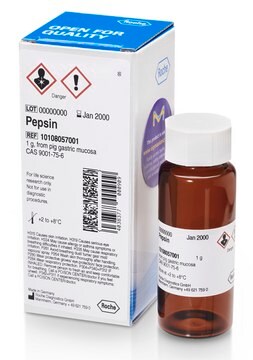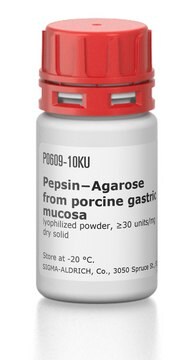P7012
Pepsina from porcine gastric mucosa
lyophilized powder, ≥2,500 units/mg protein (E1%/280)
Sinónimos:
Pepsina A, Pepsina from hog stomach
About This Item
Productos recomendados
form
lyophilized powder
specific activity
≥2,500 units/mg protein (E1%/280)
mol wt
35 kDa
color
off-white to yellow
solubility
deionized water: soluble 10 mg/mL
10 mM HCl: soluble 4 mg/mL (Cold)
UniProt accession no.
application(s)
diagnostic assay manufacturing
storage temp.
−20°C
Gene Information
pig ... LOC396892(396892)
¿Está buscando productos similares? Visita Guía de comparación de productos
Categorías relacionadas
Application
Biochem/physiol Actions
Pepsin is the major proteolytic enzyme produced in the stomach. It digests proteins through the cleavage of interior peptide linkages.
Unit Definition
Analysis Note
Other Notes
Inhibitor
signalword
Danger
hcodes
Hazard Classifications
Eye Irrit. 2 - Resp. Sens. 1 - Skin Irrit. 2 - STOT SE 3
target_organs
Respiratory system
Storage Class
11 - Combustible Solids
wgk_germany
WGK 1
flash_point_f
Not applicable
flash_point_c
Not applicable
ppe
dust mask type N95 (US), Eyeshields, Faceshields, Gloves
Elija entre una de las versiones más recientes:
¿Ya tiene este producto?
Encuentre la documentación para los productos que ha comprado recientemente en la Biblioteca de documentos.
Los clientes también vieron
Nuestro equipo de científicos tiene experiencia en todas las áreas de investigación: Ciencias de la vida, Ciencia de los materiales, Síntesis química, Cromatografía, Analítica y muchas otras.
Póngase en contacto con el Servicio técnico











